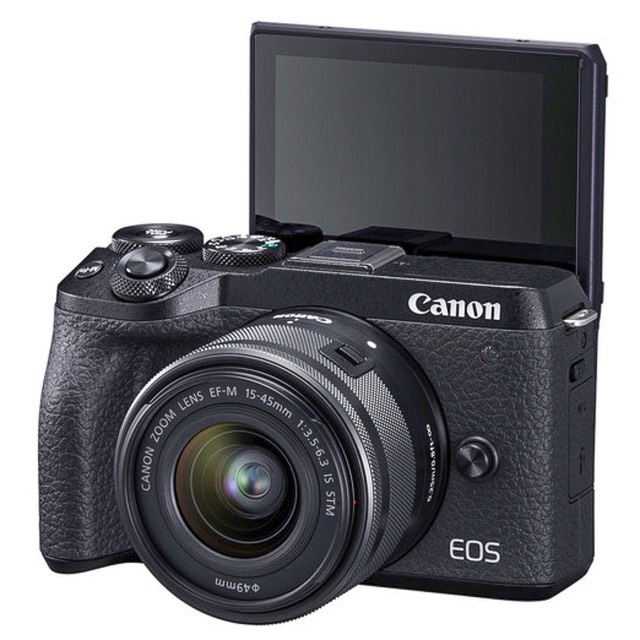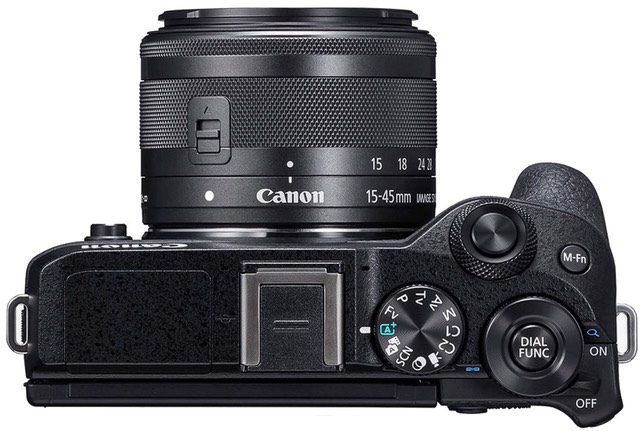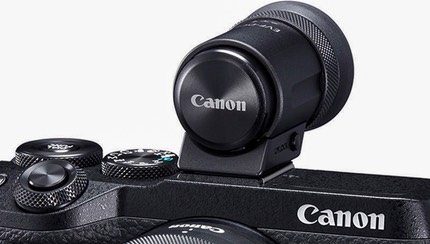
What is It?
The Canon EOS M6 Mark II is essentially Canon's top APS-C mirrorless camera (the M5 uses an older sensor and hasn't been updated). The Mark II is an update to the original M6, which sold well.
Canon originally seemed to be low-balling their mirrorless M models, shooting for some sort of entry user with low expectations of direct camera control and somewhat low focus and other performance expectations. The M6 Mark II, on the other hand, seems like it's medium-balling. It's missing a built-in EVF, and Canon never really fleshed out an M model that was above the Kiss/Rebel level, though at least the M6 Mark II has impressive autofocus and a reasonable amount of user control.
Canon dropped their excellent 32mp dual-pixel APS-C sensor (1.6x crop) into this new model. I'd tend to argue that this sensor is about as state-of-the-art as APS-C currently gets (early 2021), and it's certainly the best crop sensor that Canon has produced. The level of image quality and live view/video focus performance you can expect from the M6 Mark II is very high, about as good as it gets for APS-C.
The dual-pixel design drives the autofocus system, which covers the entire frame and has all the usual phase-detect abilities you might expect these days, including eye detection. Actual focus positioning doesn't quite extend to the two sides of the frame, but does to the top, covering about 88% of the frame. Canon divides that into 143 areas, but at the single sensor level, you can actually pick up to 5481 positions, should you be patient enough to scroll though that.
Coupled with the new 32mp sensor and its smart dual-pixel, on-sensor phase detect focus design, the M6 has an optional 2.36m dot OLED electronic viewfinder (hangs far back from the camera), a 3" and 1.04m dot tilting rear touchscreen, plus multiple direct control dials and buttons. The tilting LCD flips up to a 180° selfie position, and down to a 45° angle.

Up top we have a Mode dial, a front control dial around the shutter release, a multi-function dial, and one of the customizable buttons. The M6 Mark II has a bit more customization and direct control than the bottom end Rebel DSLRs, which is definitely a step in the right direction.
ISO runs from 100-25600 on the M6 Mark II, just as on the DSLRs with the same sensor. Auto ISO is present, including the ability to adjust the minimum shutter speed, a step forward from the M5.
One missing element is sensor-based image stabilization. The zoom lenses in the M mount are all stabilized with lens-based IS. It's in the primes and third party lenses that you might miss sensor-stabilization.
The overall camera design of the M6 Mark II works out very much like a small DSLR, but without the viewfinder. The optional EVF slips into the hot shoe, and is a little awkward, but it's centered on the lens and can tilt. The M6 Mark II includes a small pop-up flash (GN 15 ft, 4.6m at ISO 100). The right side of the camera features a deep hand grip on the lower front—at least for this sized camera—and a very pronounced thumb-hold hump positioned on the rear. Again, DSLR-like, though very small DSLR.
The M6 Mark II will shoot short bursts at 14 fps with full focus and metering, and has a special 30 fps burst mode that produces 18mp images with a further 1.33x crop (and some rolling shutter).
The dual-pixel focus system has a few wrinkles to it, including the ability to use EF and EF-S adapted lenses, but the best of these wrinkles is that ability to use the touchscreen for focus positioning while shooting (turned on and off by the Touch & Drag AF Settings menu item). You can control whether the whole or part of the LCD is active for this.
Like the low-end EOS DSLRs, the mechanical shutter in the M6 Mark II only goes to 1/4000, and the flash sync maxes out at 1/200. The electronic shutter can get you to 1/16,000 second.
As you might expect, there's built-in Wi-Fi (802.11/b/g/n) with both LE Bluetooth and NFC for ease of connecting. You can use a standard Canon wired remote, a wireless remote, or your smartphone to control the camera. USB is the now slow 2.0 type, though it does allow charging (USB Power Delivery).
Probably the one aspect of the M lineup that disappoints the Canon faithful is the video capabilities. While Canon supports a 5-axis electronic image stabilization (due to a bit of an additional crop when in video mode), the actual video settings you can make are minimal: 4K/30P, plus 1080P/120/60/30/24. The 4K video frame is not cropped (full width). Bit rate ranges from 120Mbps down to 30 Mpbs, also a bit disappointing. The camera has a stereo microphone built in as well as a remote mic input, but no headphone monitoring. A micro-HDMI port is built into the right side of the camera.
The EOS M6 Mark II uses the common LP-E17 battery pack, though the rated shot life is only 305 (CIPA).
If you have Canon EF or EF-S lenses, you can use them on the M6 Mark II with the Canon EF-EOS M Adapter, an overly expensive (US$199) tube that mostly just passes through electrical contacts. I tried a few such lenses on the camera, and they pretty much perform the way they do on the Canon DSLRs in the Live View mode. Which is to say pretty good, given the recent dual-pixel upgrade to all the Canon DSLRs for Live View, but certainly not at DSLR-levels when it comes to very long lenses and distant, fast moving subjects.
The camera body itself is mid-weight at 14.4 ounces (408g), but small at 4.7 x 2.8 x 1.9" (120 x 70 x 49mm). One SD card mounts in the battery chamber (UHS II supported).
The camera is made in Japan and sells for US$829 (body only). With the EVF and kit lens, the price is US$1099.
Canon's Web site for the camera.
Source of the review unit: 45-day loan from B&H.
How's it Handle?
In a word, like a DSLR. The twin dials coupled give you quick access to setting the camera. You will need to spend some time studying how to set up the Dial Func button, though. I simplified this to three things (Exposure compensation, ISO, and Drive mode).
Like the previous cameras, setting up the AF-on button (which is in the middle of the AF/MF switch) isn't straightforward. You'll be reading the full manual carefully to get the camera fully customized to the way you want it.
The touchscreen on the M6 Mark II is one of the things that sets it apart from a low-end DSLR, as it turns out. As I noted, you can slide your thumb on the rear LCD when shooting in order to control where the focus is made, and this even works in Face Detect mode: if the camera detects multiple faces you can slide your finger to the one you want it to use.
You also get use of the touchscreen in menus, in the quick setting mode, and even for tap-and-shoot if you're not using the optional EVF.
Another thing I don't fully understand why camera makers keep doing is the "respond from temporary sleep" issue: you have to press the shutter release part way to reactivate the M6 Mark II. No other button will activate the camera from sleep. Moreover, this reactivation is somewhat slow. (The reason they do it is to preserve battery, apparently. They don't want the camera easily woke when sleeping. Still, this slows you down for spontaneous photography.)
I'm reasonably comfortable with the M6 Mark II's handling. To me, it was more about get the camera set up to my liking than being frustrated while taking photos, which is an okay compromise. The camera does have a number of buttons that can be customized, but finding the way to customize them will take you to the manual.

The optional EVF slides into the powered hot shoe, and makes for a visually awkward appendage on top of the camera. It sticks up high and goes back behind the camera, which isn't terrible, as it allows you to your hand on the rear LCD to use as an autofocus pointer.
How's it Perform?
Battery life: As you might expect, on the poor side, particularly with the optional EVF. I actually was getting more than the 305 shots per battery charge that Canon indicates with much of my shooting without it, but I was shooting bursts and not using flash and a few other features that suck battery. When I just used the camera for some random travel photography using the EVF and popped up the flash a few times, sure enough, 300 shots per charge was stretching it.
There are some features in the M6 Mark II that allow you to extend battery life: you can put the display in Eco mode (dims after two seconds of inactivity), for instance. But these are band-aids on the bigger problem (too small a battery for a serious consumer of energy).
Most of us mirrorless users have by now figured out that we need a small handful of batteries and a dual-battery charger (e.g. the Watson models at B&H) to keep our frustration with our cameras from boiling over. The M6 Mark II is no different: I wouldn't head out for a full day of shooting without two or three batteries. I'd probably fully use at least two of them. At least that's been the early pattern.
Write Speed/Buffer: One thing to note is that the EVF doesn't keep up with fastest bursts: you get the dreaded "last image slide show" effect. But assuming you can deal with that, you can get almost 20 images into the buffer before, gulp, the camera loses responsiveness. If you keep your finger on the shutter release, you'll get a clack every second or so as a new shot fires off. But if you remove your finger, the camera won't really be useful until the buffer has cleared, and that was 20+ seconds in my testing.
I mentioned clacking: the mechanical shutter on this camera is about as noisy as I've encountered in recent cameras.
Autofocus: The dual-pixel design first appeared on the Canon 70D.
The slight horizontal restriction to selecting focus sensors has to do with the fact that each of the pixel pairs only look at half the lens. So obviously as you near one edge of the sensor, one of the pair will be looking outside the aperture area and not seeing anything. Still, coverage is excellent at almost 90% of the frame.
Moreover, I didn't find the restriction problematic at all. Most of the time I want to focus in the middle two-thirds of the frame anyway, so there wasn't an issue. And I don't really need tracking focus performance at the edge.
I've seen tests where people say that the M6 Mark II is just as good as a DSLR. I wouldn't put it quite that far. But the M6 Mark II does track fast, probably better than any other mirrorless camera in its price class.
Face detect works great on humans, not so much on animals.
Image Quality: simple answer: the EOS M6 Mark II results look like a good Canon DSLR's results. As I've noted earlier, I consider the 32mp sensor in the M6 Mark II to be state-of-the-art, and for the most part, it is.
Why did I write "for the most part"? Because Canon's JPEG rendering is sub-optimal to what this camera can do. Even at ISO 800 Canon's default noise reduction was smearing detail compared to what my other APS-C cameras would do. By ISO 3200, the loss was considerable. Yet, when switching to raw, I could pretty much match results from the M6 Mark II to the best APS-C cameras (we'd argue over some very minor differences; you have to do a little more color noise reduction on the M6 Mark II than my Nikon D7500, for example).
Canon's default sharpening also leaves something to be desired for JPEGs. At first I was wondering whether the extra pixels on the sensor were showing up the deficiencies of the lens I was using. Then I realized that I was looking at JPEG results and started sleuthing around. Bingo. I can do better sharpening in raw than the DIGIC processor is doing.
That said, with some trial-and-error you can absolutely get better JPEG results out of this camera than Canon's defaults, which are a bit ham-handed. Raw shooters need not be concerned, though you're going to have to find the fine line between noise reduction and sharpening that works as you boost ISO values.
Yes, you still can't pull up quite as much deep shadow detail on the M6 Mark
II as with the Sony-based crop sensor cameras (Fujifilm, Nikon, Sony). That's long been an issue related to Canon's sensor technology design versus the Sony Exmor. But Canon has closed the gap enough so that I don't find that problematic.
In out-of-camera raw files up through about ISO 6400 there's really not much to separate the two: both the Sony sensor cameras and the Canon M6 Mark II are just on the edge of producing clear color noise that can't easily be removed without other impacts. But you're doing that with 32mp on the M6 Mark II and only 20mp (Nikon Z50/D7500), 24mp (Sony A6### models), or 26mp (Fujifilm X models). That's not as much resolution difference as you might expect, but it might make a difference to you in a few cases.
Here in early 2021 I'd put my crop sensor ratings in a very tight range, but (1) Canon 32mp, (2) Nikon 20mp, (3) Fujifilm 26mp, and (4) Sony 24mp. Each has something on the others, but you really have to evaluate everything together, and that's what I come up with today. But again, a very close race. Most people won't be able to distinguish.
Final Notes
If you don't want an EVF and can live with framing via LCD, the M6 Mark II is probably the best camera you can find for that. It's got a bright screen sitting on a small body, but packs one heck of a lot of image quality inside.
I'm less excited with the optional EVF, as it's a bit awkward, sitting up high and far back on the camera, and it drove my battery life down.
The big issue you need to consider is the M mount and its lens set. The 15-45mm f/3.5-6.3 kit lens is okay in that it gets us right at the 24mm equivalent at the wide end, but its not a terribly strong performer compared to the competition (the Fujifilm 15-45mm and Nikon 16-50mm would be my first choices in terms of crop sensor kit lenses). Neither is the Canon 18-150mm or 55-200mm zoom (the Nikon 50-250mm blows the Canon telephoto zoom away). The sensor is outperforming the lens with those zoom lenses on the M6 Mark II.
On the other hand, I really, really like the 11-22mm f/4.5-5.6 lens on this camera, which makes for a very compact wide angle zoom package for travel that produces excellent results. Canon's three primes are all fine, but don't open up a lot of flexibility. Sigma's three DC DN lenses give you a little more choice. But overall, if you want lens flexibility it's going to come with using the EF-to-M adapter, which adds bulk to your system.
I really like the still image quality of the M6 Mark II raw files. I mostly like the size and UX of the camera itself. The video doesn't get me excited. And I find the lens set not filled out (buzz, buzz). I almost bought the review camera just to use with my 11-22mm lens: that's a dynamite combo if you need that focal range. But I didn't, mostly because in the end I didn't feel like the M6 Mark II was flexible enough for everything I'd want in a really small camera. And that came mostly down to the other lens choices.
So, if you can live with the current M-mount lens set, this is a camera you shouldn't rule out. Indeed, if you can find the lenses you want for the M6 Mark II, I'm pretty sure you'll love the image quality.
Recommended (2021, 2022) (with lens reservations)